Tabled: Race and Identity
TRANSCRIBED BY COURTNEY KING, EDITED BY EMMALY WIEDERHOLT
Tabled, a project by Chlo & Co Dance, takes what has been set aside – “tabled” – and brings it into conversation. The five-panel series runs from March through December 2021. The first panel, “Race and Identity,” was held on March 17th via Zoom and featured Bay Area artists Jhia Jackson, Fanny Kahlo, and Katie Wong. This transcribed and edited version seeks to continue the conversation.
Questions for panelists:
- How do race and identity manifest in your art?
- How is race addressed or not addressed in arts communities?
- What revolution(s) do you want to see within the arts?
~~
Fanny Kahlo: My name is Estefanía, but people know me as Fanny. I have been living in San Francisco for more than 11 years. I currently do a lot of different projects, but one of the main things is I run an online queer Latinx vintage shop, Ojo x Ojo. I created it with the idea of having a space not just about clothing, but to make a space for people who look like me or who I didn’t see growing up.
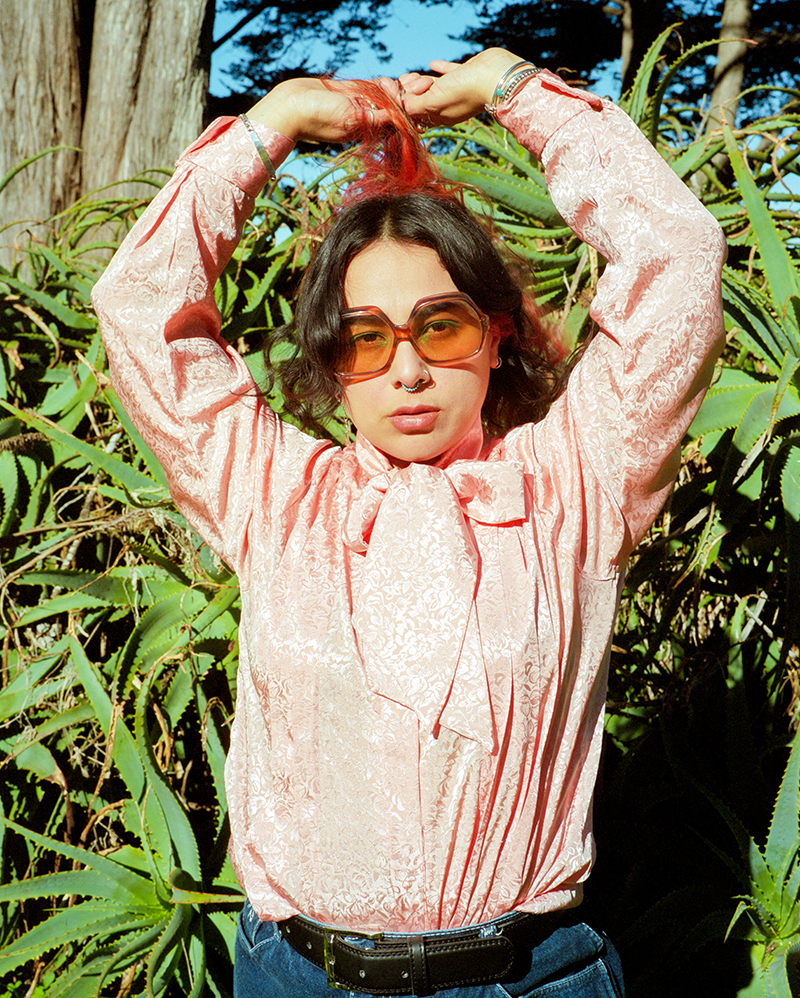
Fanny Kahlo, Photo by Ralph C.R.
Jhia Jackson: My name is Jhia Jackson and my pronouns are she, they. I am a movement-based artist and scholar in San Francisco. I am currently getting my doctorate at UCSF in medical sociology, where my research is on death, dying, and end-of-life care. I’m also the founder of Emerging Black Bay Artists, a grassroots organization in the Bay Area dedicated to connecting and supporting early to mid-career Black artists of all disciplines. I often engage in other people’s works as a dancer or costume designer. And then I lead my own projects, which are movement-based and sometimes manifest as stage performances, site-specific works, virtual, or all-written.
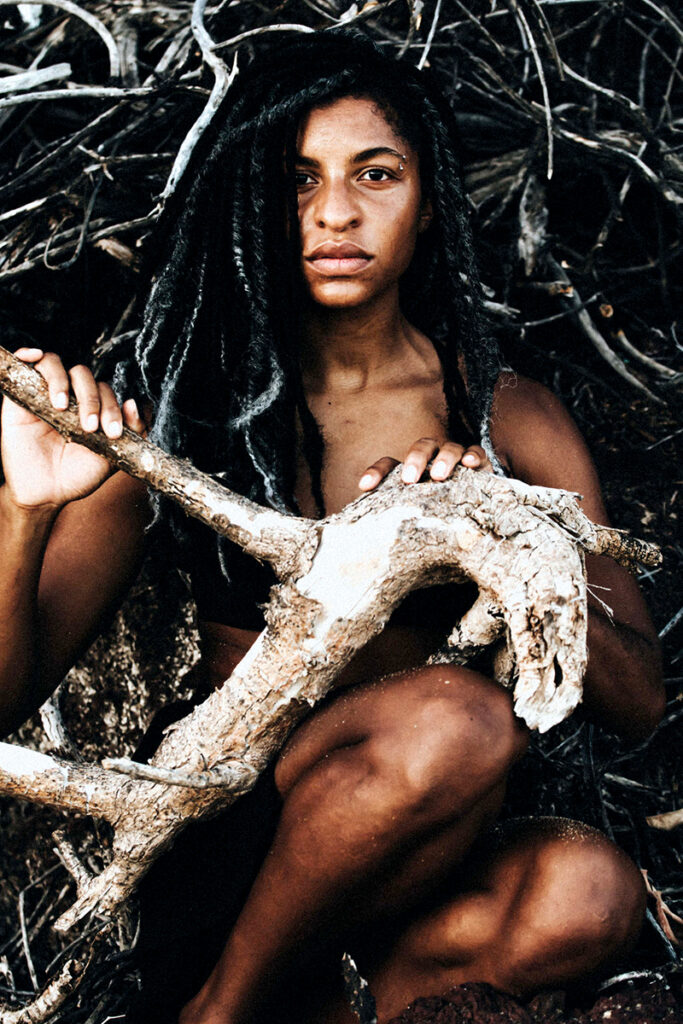
Jhia Jackson, Photo by Thais Aquino with Mojo DeVille
Katie Wong: My name is Katie Wong and I use the pronouns she, her, hers. I’m a movement artist and choreographer who has been based in the Bay Area for almost 10 years. As a freelance dance artist, I’ve worked with more than 15 local companies and choreographers. I’m also a freelance choreographer and have been commissioned by a variety of organizations. Two and a half years ago, I joined the leadership of RAWdance, first as an Associate Artistic Director and now as Co-Artistic Director, and helped shepherd our company into an expansion, not only by moving beyond the two original founders to include myself but also in our location. We are still based in the Bay Area, but our two founders moved to the Hudson Valley in New York. We’re now exploring what it means to have this bicoastal model together.
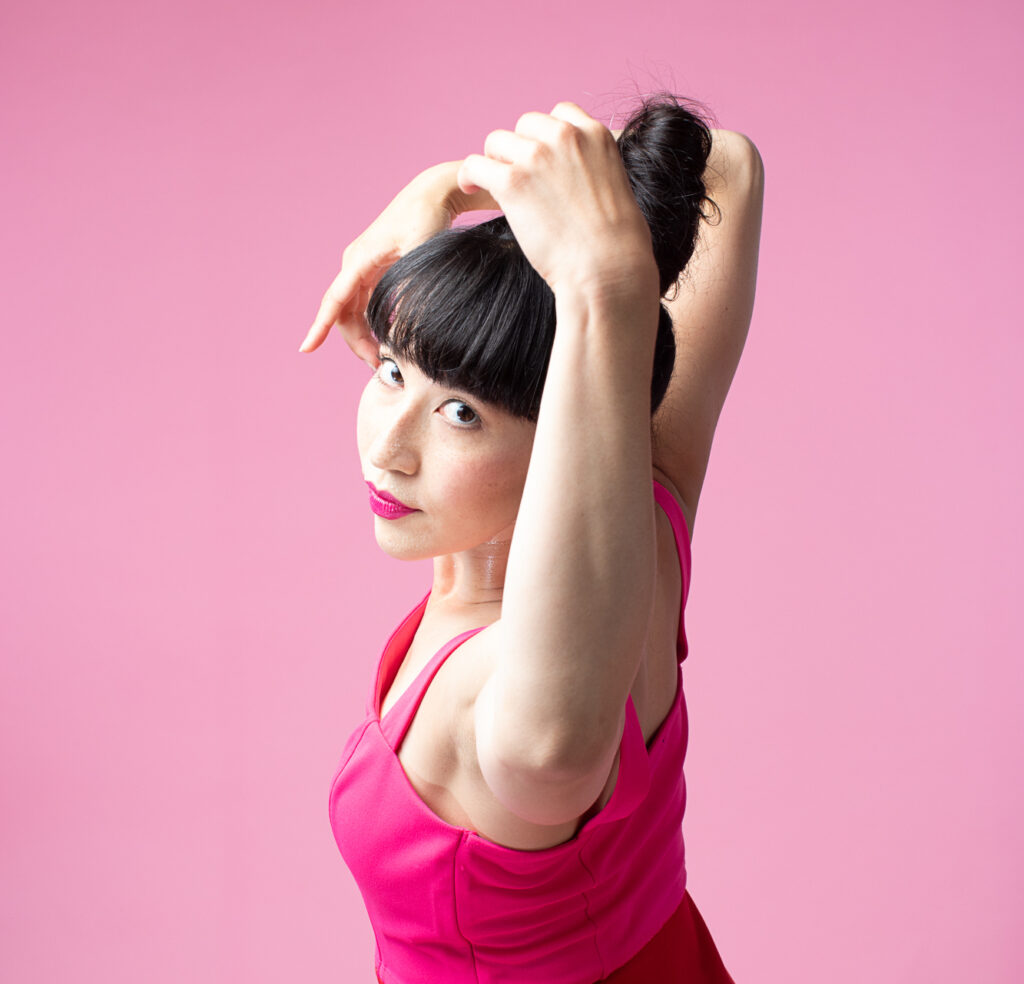
Katie Wong, Photo by Elena Zhukova
Thinking about the first question, early in my career, so much time was spent on survival and auditioning. How do you join a company based on a one-weekend audition? We’re taught to fit into a mold and emulate the choreographer. It often felt like an erasure. So infrequently were you invited to be your authentic self in the space. That felt troublesome and problematic. It wasn’t in every circumstance; there are many choreographers out there who try to create opportunities to get to know dancers better. But it’s certainly an important norm to continue to evaluate in our field.
There is a shift when it comes to becoming a choreographer; I’ve been able to step into my own identity and voice. One thing I’ve held onto is my values when approaching rehearsal with others. It is connected to my upbringing and the different cultures I hold within my personal history where we prioritize listening, respect, creating a safe space for voices to be heard, giving credit where credit is due, compensating people for their time and labor, and showing kindness and generosity.
Fanny: Coming from a background where my art is not my primary source of income, I think everything is amplified when it comes to having another 9-to-5 job and still finding the energy to make some art, be creative, and take the time to think about what I want to create. That’s how I view race and identity and how it manifests through my work; I haven’t had the privilege to make my art my primary focus.
Jhia: I love that you brought up the question of who has access to make art their livelihood. Art is literally a privilege you don’t have access to if your basic survival needs aren’t being met.
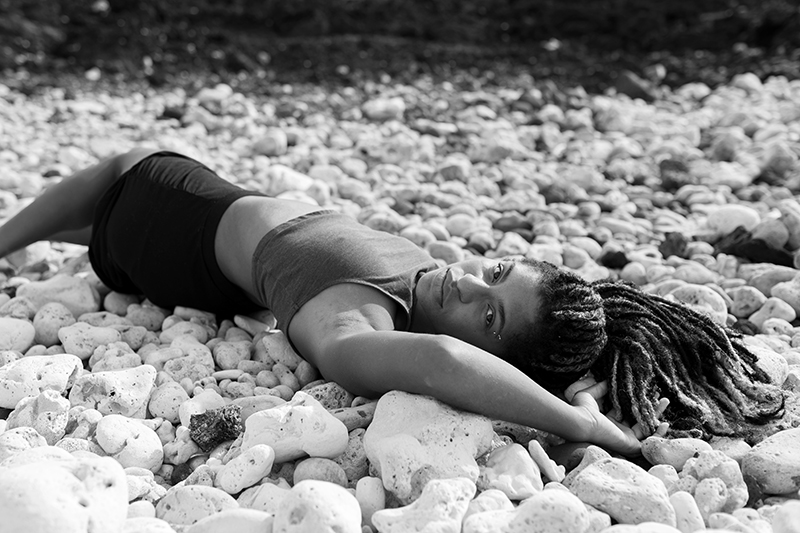
Jhia Jackson, Photo by Matt Goldhill
Something I’ve been struggling with, especially during the pandemic, is suddenly everyone’s Instagram has turned professional. I don’t know when we stopped posting pictures of our cats and started posting headshots all the time. Suddenly our Instagram profiles have become our businesses, our self-marketing.
Fanny: When I step back and see the opportunities that have been provided to me through a platform like Instagram, I feel like it was based on me presenting who I am. Instagram has changed a lot and sadly. Everyone’s promoting the same brands, the same style, and it’s very dull and boring to me.
During the pandemic, because I’ve been stuck inside all day not meeting people at pop-up events or clothing shops, it’s all been through Instagram. It’s been hard for me. It’s heavy to understand: What is Fanny Kahlo? Because that itself is my brand, Fanny Kahlo and Ojo x Ojo shop. I want to continue to show that there are people who look like me who were raised by strict Mexican parents. My parents never told me, “You should look into the arts if you’re interested.” It was always, “That’s not going to provide you any income.” There was never a conversation about art. I want to continue to be on Instagram and other platforms, but it’s so hard when you’re not agreeing with what you’re seeing. I need to be reminded that you can put yourself out there and just be yourself, and opportunities will present themselves. It’s about finding that middle ground of when sharing yourself is too much.
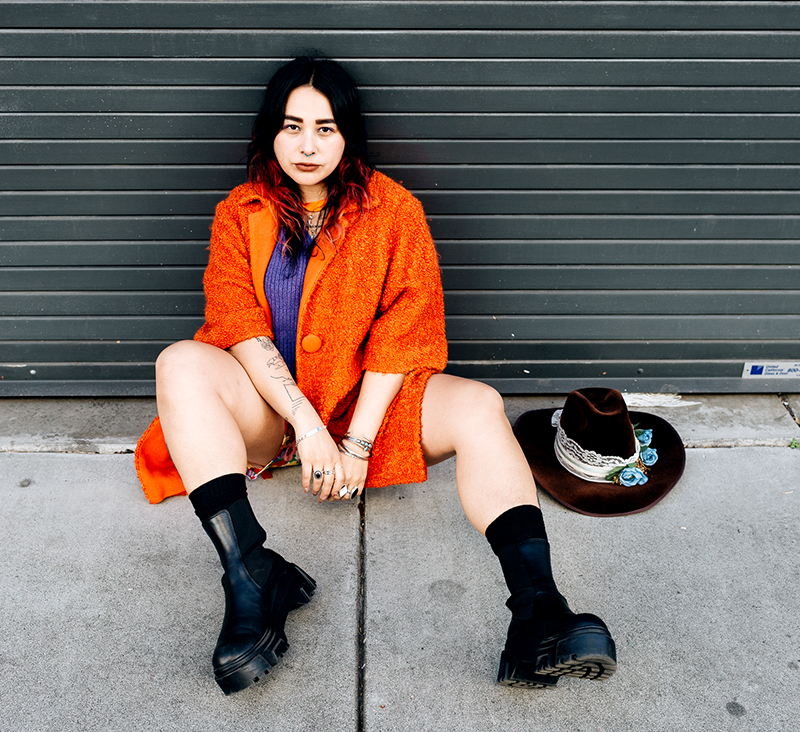
Fanny Kahlo, Photo by Lindsey Shea
Jhia: That’s a central question for me: When is sharing yourself too much? I think back to when I first met you, Katie, and where I was in my journey around liking myself and liking my skin tone, which is a weird thing to say because I’ve always loved the fact that I’m Black. My parents met at Howard. They were both in frats and sororities. Even though I have been schooled in predominantly white institutions and danced in overwhelmingly white spaces, I’ve always had a grounding in Black culture. I didn’t have that phase of not necessarily embracing the fact that I’m Black, but rather the questions of, “I’m too Black here, I’m not Black enough there, I don’t quite fit in, I’m just dark enough to read Black onstage, but I’m not Black enough to read Black for your piece.”
A strength of mine is that I literally cannot lie to you. I can’t do it. Don’t invite me if you don’t want me to open my mouth. We’re in the Bay Area where there are hella Black dancers. I know y’all think there aren’t, but there are so many. That’s why I made a group, Emerging Black Bay Artists, so you don’t have to pick me. You can pick all these other artists.
Every time I open my mouth, I’m suddenly that angry Black woman. Then the pandemic happened and suddenly y’all want me to open my mouth. You fired me from your dance, you told me I was mean, you let your dancers point at me and cry and yell. And I had to be quiet and take it because if I open my mouth, I’m an angry Black woman, when I’m actually the sweetest.
From Jhia Jackson’s “Of Crowns and Cages”
I have a friend, Liz Mulkey, who I collaborate with in LA. We made this dance and performed it at Movement Research in New York. Afterward, this Black dancer came up to me and said, “I have never seen a Black person dance like that.” That’s why I have to show up, for that one person who says, “I didn’t know that was possible for someone who looks like us.”
I love being in other people’s work. It gives me a chance to learn and test my own limits. But I have found over the years that if someone asks me to work with them, I let them know the things that are important to me, which are communication and transparency. I know what it feels like to be gaslighted because everyone else is acting like things are fine, but things are very clearly not okay. I don’t understand why we in the arts community are advocating for change, for activism, for economic empowerment, if we’re not showing up for each other. In my artwork, a commitment to upholding my personal values around the way that we, as humans, should strive to treat each other is central.
Katie: It’s important to continue to share those stories with our community because we all experience them from different perspectives. It’s all about representation. The first choreographers I worked with in the Bay Area were both women of color. Without those experiences, I would not see myself where I am today. It is that vision, that perseverance, and that possibility that completely opens doors.
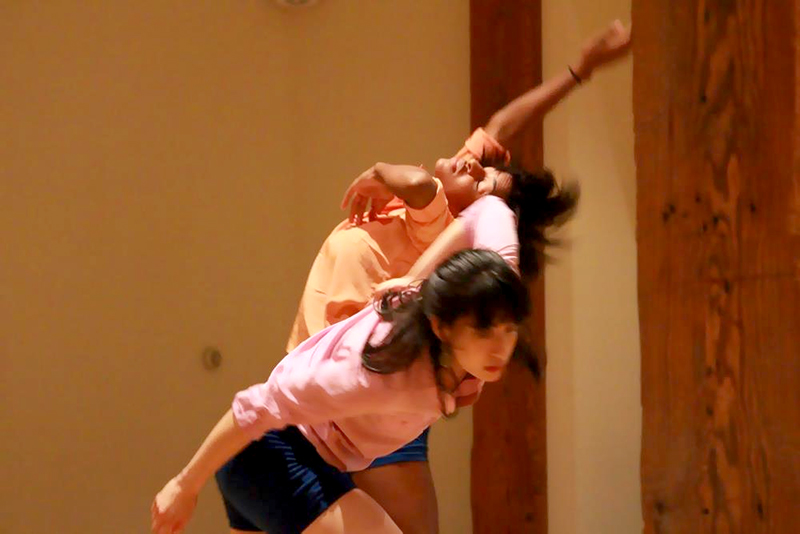
Jhia and Katie performing in PUSH Dance Company (choreography by Raissa Simpson). Photo courtesy PUSH Dance.
Walking those boundaries between sharing too much or too little, making ourselves our brands, these are difficult questions when it comes to vulnerability in our art. It is towing that line, making sure you’re saving time for yourself, your care, and your personal space, but also realizing the power you have in your Instagram account or in your performance where someone you might not know is going to meet you and your work for the first time.
Jhia, it resonated with me the way you’ve been able to build a connection with Black communities while living within primarily white institutions. The struggle I’ve had with my art and identity has been around being mixed race and feeling like that must mean my experiences are watered down and not as authentic. I never really fit into specific containers; which box do I check? Can I check more than one? It’s about stepping into that strength and seeing it not as a disadvantage, but as a superpower. I have a massive amount of history, an incredible number of ancestors to draw on, and multi-layered cultures. That is such a benefit and something I am grateful for, but it’s been a journey to get to this point of understanding and appreciation.
Fanny: Moving to San Francisco from a small agricultural town, I had to ask if I wanted to try and fit in with people who have no relationship to me. Or am I going to just continue to focus on what I’m here to do? I could be placed into this box of looking a certain way and following certain trends, or I could continue to learn about me.
With that is the question of how race is addressed in arts communities. It’s something that has recently started to happen. There’s also this idea that everyone is trying to make money off people like us. Suddenly everyone wants to work with people who are of color or queer, but what are the motives behind that? It’s hard to navigate the idea of feeling used but also feeling empowered.
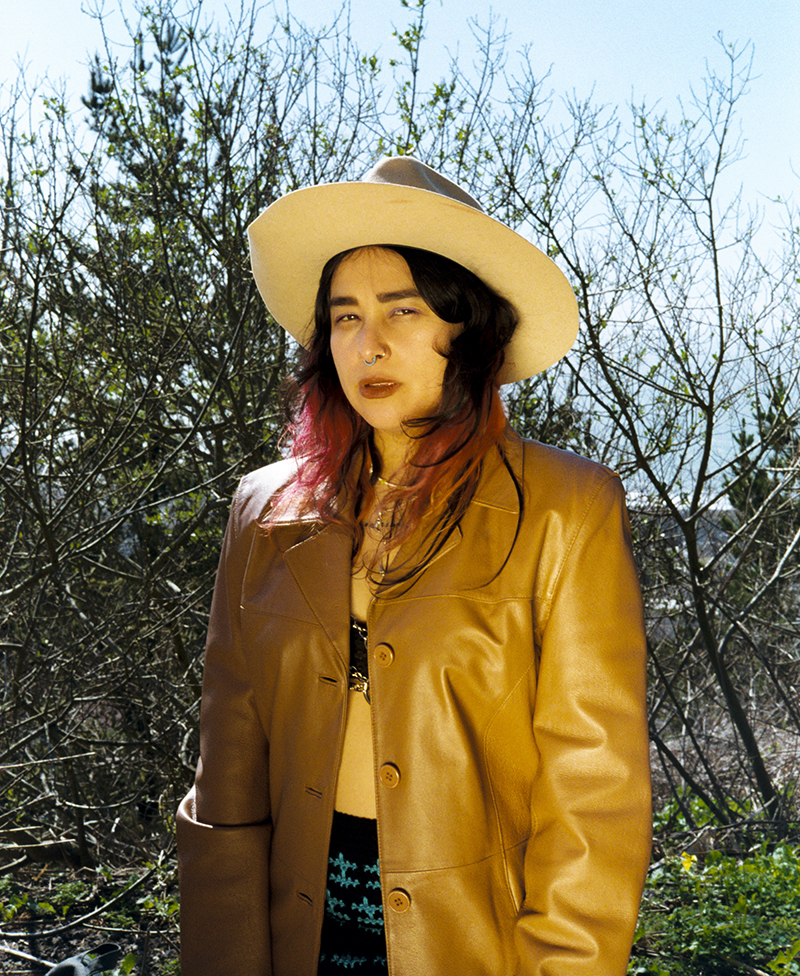
Fanny Kahlo, Photo by Katie Walsh
Jhia: Something I’ve been thinking about is: Are there aspects of my identity that I can’t help but have people know? For the most part, you look at me and you immediately know I’m Black, but the fact that I’m bi doesn’t necessarily come forward in my art. We have more readily seen and less readily seen aspects of our identities. Some things can’t help but come forward and other things you have to assert.
Fanny: I studied sociology and Latinx studies in college. I was taken aback by how much history I didn’t know. I come from a very strict, religious, Mexican background. Most of the time now, I’m in spaces with white folks who come from money. They’re just sourcing clothing as a hobby. I do it because I want to provide this space for people like me. It’s hard, but doable. I’ve been able to have my 9-to-5 job, but also create art.
Katie: The first work I did as Co-Artistic Director of RAWdance, called The Healer, came from a personal place. It was connected to the loss of my aunt and her relationship to our Chinese culture and ancestors as well as to Eastern medicine. I was reintroduced to these philosophies during my time on the West coast. The more I researched and reached out to Bay Area Asian communities, the more it felt like an opportunity to create space to hold our histories and share my personal grief and healing process. Realizing how art can be a tool and container for connection and growth was beneficial for me.
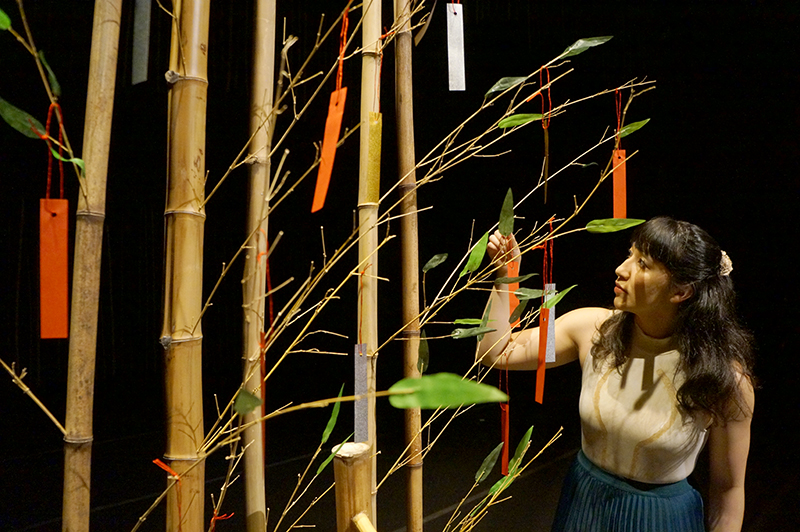
Photo by Stacey Yuen of Katie Wong’s “The Healer”
Jhia: Hearing both of you talk about how your work as artists has allowed you to reclaim and rediscover aspects of your identity hits me so good. My dad has Parkinson’s disease. He’s actually been living with it since I was nine, but I didn’t know until I was 16. A couple years ago, RAWdance asked me to show work in their Concept Series. I asked my dad if he would dance with me. We made this piece based on interviews with my grandma, who was a sharecropper’s daughter. We would be driving through Louisiana and she’d say, “I used to pick that cotton.” I’d look at her like, “Damn, that shit was not that long ago.” I interviewed her about the way my family has spread and also asked her thoughts about my dad’s chronic illness.
Then my dad and I made this structured improv, which is a big deal because Parkinson’s disease causes impaired motor skills and cognitive slowing down. We performed at RAWdance’s Concept Series and at a bioethics conference. Especially in dance where our bodies are so much of our identity, it’s been lovely to have this vessel to talk about family, bodies, and illness.
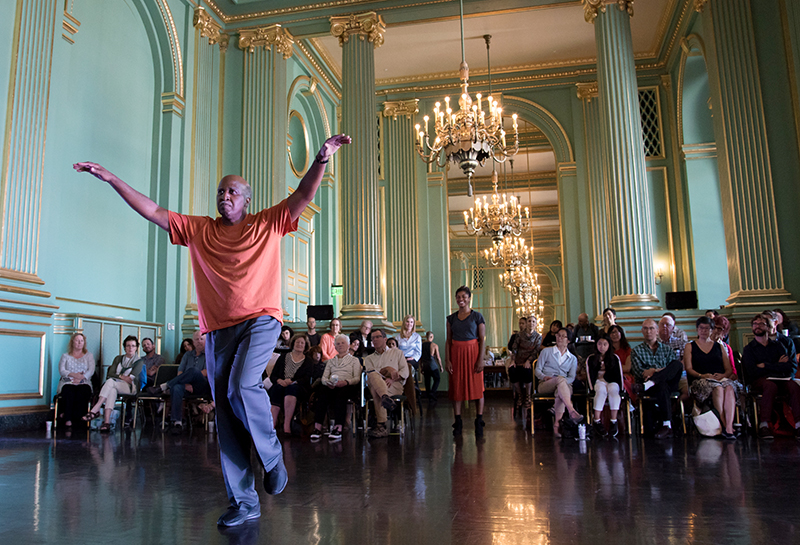
Photo by Amal Bisharat Photography of Jhia Jackson’s “Daddy Issues” (2018) at SF War Memorial for RAWdance Concept series.
Audience question: This past year, everything has obviously taken a lot out of us. How have you been able to give yourself some self-love? How do you find balance?
Fanny: At the beginning when everything started to close, it was hard to find that balance, especially navigating from working in an office to working at home. I started to meditate. I was never a person who could shut my brain off. I still have a hard time, but that has really helped me just be present.
Katie: I’m always trying to chip away at what it means to say yes or no to projects. How do you gracefully understand how to monitor your time and not give everything you have away? That was tough for me to do before the pandemic. Now, if I come out feeling rejuvenated, if I come out not feeling completely worn down, if I come out learning something to take with me for the future, then it is a successful experience.
Jhia: I instituted this practice called Sundays are for the water. That is my day when I turn to myself. The other days I try to set boundaries on my energy. I found that just communicating with people about my energetic boundaries is helpful. Alternately, I do need to throw myself around to release emotion, but I have found other ways to get that same feeling.
Audience question: What revolutions do you want to see within the arts?
Fanny: In my personal experience, when I’ve been asked to be part of any conversation, a white person always has to be the one talking. That would be something I would love to see change. A lot of folks are aiming towards that goal, but it has a long road ahead.
Jhia: I love that predominantly white institutions hire a Black artist to lead Black-centered work, but then why aren’t they practicing how to collaborate with people intentionally as opposed to just dropping us in? People have a Black Lives Matter profile picture, but then they don’t hire Black dancers, they have one Black friend, and they’re not owning up to their past mistakes or awkwardness. These aren’t things we expect people to get perfect. But if art is supposed to be about possibilities, dreams, futures, and envisioning, then why is that limited when it comes to the awkward personal things? That’s the revolution I want – some humility, grace, practice, and support around the hard things.
Katie: The few things I might be able to add is valuing artists as humans and not just as sacrificial culture bearers. Pay artists a living wage, pay them for their labor and time, not just when they’re in rehearsal or for a performance, but for every hour they’re spending in preparation, for their technique classes in order to maintain their skills and perform at their highest level.
All that has to do with shifting our social understanding around philanthropy. We can’t just hope the same large donors, foundations, and governments that change every four years are going to prioritize artists. We need to band together and re-strengthen our relationship to giving back. That includes all nonprofits, but especially the arts, because I feel like we’re often taken for granted. We shouldn’t have to wait tables and be bartenders. There should be a support system from our nation and also from the pockets of individuals. Giving back is essential.
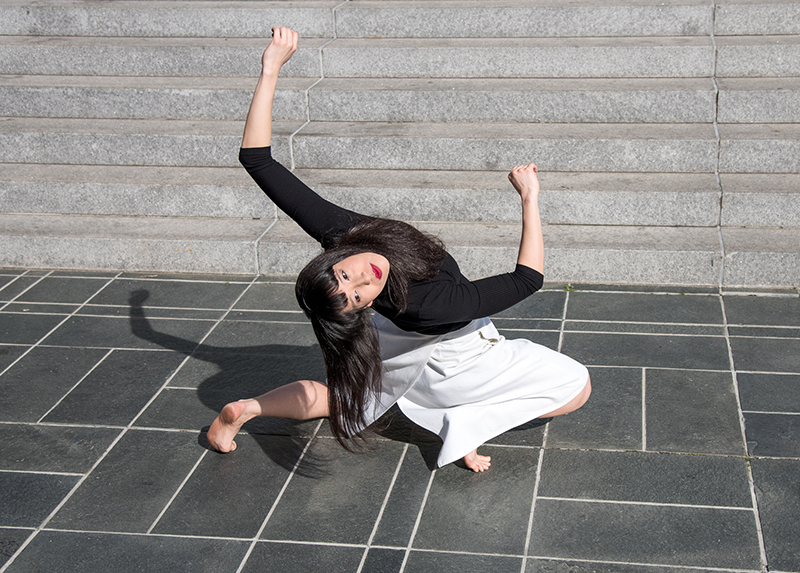
Katie Wong, Photo by Hillary Goidell
Jhia: Suffering doesn’t make our art any more artsy. If you had happy artists who didn’t have to worry about their economic stability, maybe everyone’s art would be better, it would be easier to make, and it’d be more enjoyable and interesting to engage with.
Katie: We should all uphold this narrative that artists can be strong, employed, and comfortable.
Fanny: A revolution for me would be to continue to build community, to continue to empower one another, and to continue to ask questions and learn.
~~
To learn more, visit www.chlocodance.com/tabled
